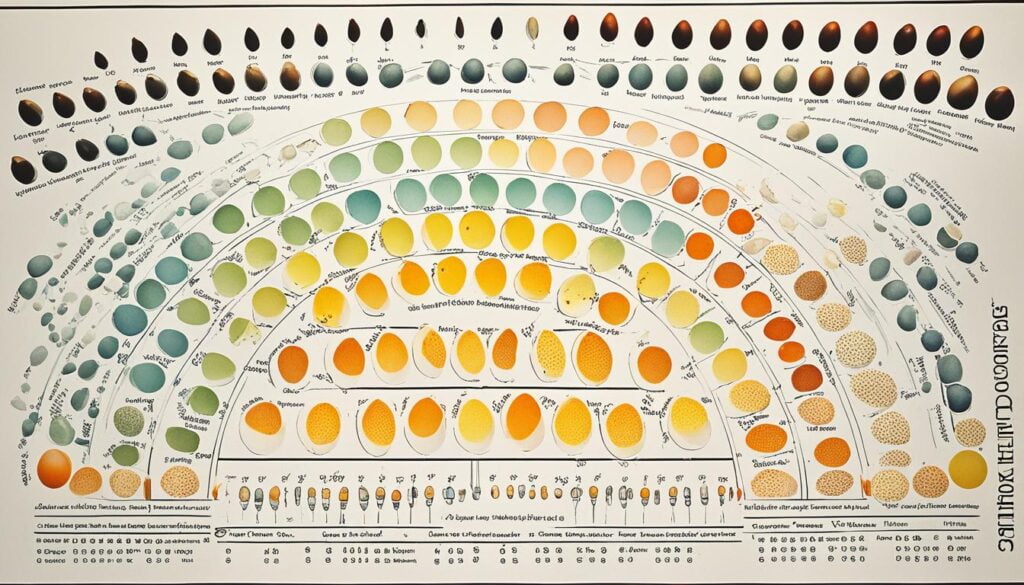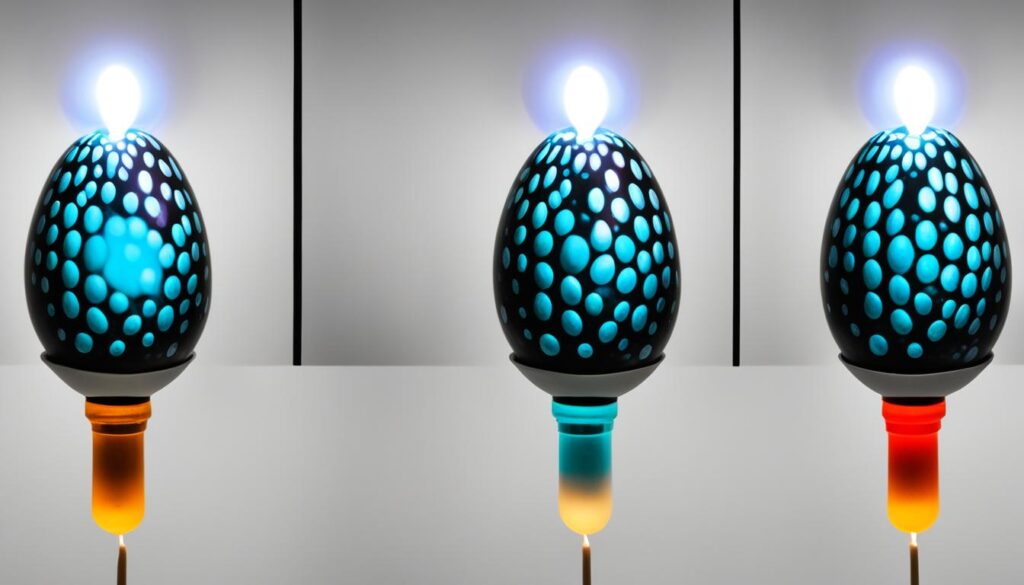Your guinea fowl egg candling chart is a critical incubation tool that aids in monitoring guinea fowl egg development during the pivotal 28-day guinea fowl egg incubation period. As a hobby farmer, you’re well-aware that successful hatchings hinge on the precise control of incubation conditions and diligent monitoring of egg viability. Through candling guinea fowl eggs, you gain visual insights into the mysterious transformation unfolding within each shell, enabling you to make informed decisions that enhance the likelihood of welcoming healthy keets into your backyard farm.
By adhering closely to the detailed guidance of a candling eggs guide, your candling proficiency will grow, as will your confidence in discerning which eggs harbor the promise of life. Aligning real-life experiences with experientially verified egg candling patterns charted by fellow aviculturists, you’re poised to navigate the intricate incubation terrain with a steadier hand and clearer vision. Remember, laying the foundations of successful guinea fowl chick development begins with correctly identifying and nurturing viable eggs.
Key Takeaways
- Consult your guinea fowl egg candling chart as a reliable reference throughout the entire 28-day incubation trajectory.
- Understand how to maintain optimal temperature and humidity levels critical for guinea fowl egg development.
- Recognize the growth milestones—such as the spider-like formation on Day 7 and opacity by Day 14—through candling guinea fowl eggs.
- Identify non-viable eggs early on to prevent contamination and protect the health of developing embryos.
- Incorporate the best practices highlighted in a comprehensive candling eggs guide to maximize your hatch rate.
Understanding the Egg Candling Process for Guinea Fowl
As a hobby farmer embarking on the journey of incubating guinea fowl eggs, you’re immersed in a process where tradition meets technology. The age-old egg candling process equips you with insights into the heart of guinea fowl egg development. With this guide, you’ll unravel the intricacies of candling eggs at home, providing the optimal conditions to bring your future flock to fruition.
The Basics of Egg Candling and its Importance
Candling eggs for beginners may seem daunting, but it’s a fundamental skill that reveals the growth inside your guinea fowl eggs. Utilizing the egg candling process, you have the privilege of visually verifying the vitality and development progress of your eggs. A bright, focused light source is the cornerstone of this non-invasive technique, offering a glimpse of guinea fowl egg stages and ensuring a healthy hatch.
Choosing the Right Equipment: Candlers and Incubators
The quest for successful hatching begins with selecting the right tools. A reliable egg candler is your window into the guinea fowl egg stages, while an incubator with precise temperature and humidity controls is your nurturing habitat. Discover how to choose suitable equipment for your setup, elevating your hatching experience from simple aspiration to tangible achievement.
Deciphering the Lights and Shadows: What You’re Looking For
The illuminating glow of the candler contrasts the light and shadows telling the tale of embryonic life. Through the lens of candling, witness the spider-web veins of a viable guinea fowl egg and distinguish these from the unwelcome signs of halted development. This mastery of observation is at the heart of the candling eggs guide, a skill cultivated through practice and patience.
Ensuring Guinea Fowl Egg Viability Through Candling
Closely monitoring guinea fowl egg development through candling is more than just routine; it’s a commitment to the livelihood of your incubating eggs. Identifying viable from non-viable eggs not only serves the health of your flock but safeguards your hatching timeline. Learn how to interpret the signs and make timely decisions that directly influence the success of your guinea fowl egg hatching journey.
| Day of Incubation | Expected Development | Viability Signs | Action to Take |
|---|---|---|---|
| Day 7 | Visible blood vessels, embryonic heartbeat | Developing blood network | Keep in incubator |
| Day 14 | Enlarged embryo, less light passing through | Active embryo, increasing opaqueness | Remove non-viable eggs |
| Day 21 | Air sac enlargement, embryo occupies most of the egg | Movement of embryo, clear air sac delineation | Maintain incubation conditions |
As you nurture your brood with diligence through the candling guinea fowl eggs process, you’re fostering life with every check. Your candling eggs at home routine stamps its mark as an essential element in the miraculous cycle of birth, providing a clear and rewarding pathway from candling to hatching. Armed with this newfound knowledge, each step you take is a stride towards a vibrant and lively guinea fowl brood that started from a simple beam of light.
Guinea Fowl Egg Candling Chart: Monitoring Development Stages
As a hobby farmer nurturing guinea fowl, you understand the significance of careful monitoring during the egg incubation process. The guinea fowl egg candling chart is not just a tool—it’s your roadmap to witnessing the miracle of life, one candle at a time. It’s all about timing: catching that first glimpse of life on day 7, ensuring continued growth by day 14, and preparing for the grand finale during the lockdown period. Let’s delve into the expected milestones and craft your personal hatching timeline.

Utilizing a candling chart, you’ll witness signs of vitality and development. From the initial pop of the embryo to the progressive filling of the shell with growing life, your assiduous care is reflected in each developmental stage. Below is a comprehensive table that summarizes your observations through the guinea fowl egg hatching timeline.
| Incubation Day | Expected Development Visible By Candling | Next Steps |
|---|---|---|
| Day 7 | Veins spider-webbing, embryo size of a small dot | Continue consistent incubation, maintain optimal temperature and humidity |
| Day 14 | Increased embryo size, air sac growth, decreased visibility | Remove non-viable eggs, adjust humidity if necessary |
| Day 25 | Embryo fills most of the shell space, begins positioning for hatch | Begin lockdown period, stop egg turning, and increase humidity |
| Day 28 | Signs of pipping as keets prepare to hatch | Monitor for hatching, assist if needed following proper guidelines |
Remember, the candling chart serves as a guide, but each egg is unique—some may be ahead or slightly behind—and that’s okay. Maintain a journal to record your observations, compare them with the chart, and adjust your care accordingly. Having a reliable guinea fowl egg incubation plan in place will yield a buzzing brooder of healthy keets in due time. It’s a patient wait, filled with minute but mighty victories, leading to the moment that defines your journey—the successful hatch.
Incorporating Candling into Your Guinea Fowl Incubation Routine
The art of successfully incubating and hatching guinea fowl begins with regular candling to assess the development of your precious eggs. Seeing the embryos evolve from tiny pinpoints to vibrant, moving life forms is not only fascinating but essential within your bird rearing venture. To ensure you’re on track, include candling in your guinea fowl egg incubation schedule, strategically timing these inspections to promote robust growth and minimize stress on both you and your expectant eggs.
Timelines and Frequency: Best Practices for Candling
For burgeoning and seasoned hobby farmers alike, timing is everything. Ideally, you should perform your initial candling session on day 7, to confirm the presence of veining and to ensure there are no cracks or imperfections. The subsequent candling on day 14 lets you track the guinea fowl egg stages more closely, allowing you to weed out any eggs that fail to show expected progress. By integrating this cadence into your routine, you foster an environment where every developing chick has the best chance for success.
Interpreting Candling Results During Different Incubation Phases
When you candle guinea fowl eggs, the contrasts you observe beneath the shell provide profound insights into the viability of each egg. In the early days, the candling eggs guide will help you identify a halo of blood vessels and the embryo at the center—the indicators of life. Progressing into the guinea fowl egg development journey, you’ll witness the embryo’s increased activity and growing complexity, with clear visualization of differentiation by day 14. Mastering this interpretative skill not only enhances your candling eggs at home experience but also promotes a more successful hatching timeline.
Common Challenges and How to Address Them
Not all eggs are equal, and some may pose challenges—like opaque shells that hinder clear observation or stable environment maintenance issues. Address these impediments by ensuring your candling space is adequately dim and by maintaining a hawk’s attention to the incubator’s climate. Utilizing a guinea fowl egg candling chart as a visual aid can help you adjust your approach as needed, thus improving your aptitude for spotting healthy development versus stagnation.
Moving From Candling to Hatching: Final Steps and Troubleshooting
The transition from attentive observation during candling to the anticipation of hatching marks the culmination of your efforts. Embrace the lockdown period by ceasing rotation and heightening humidity, creating ideal conditions for your keets to pip and zip their way into the world. Mind the humidity closely—resisting the urge to frequently check—maintains the required environment to prevent complications such as shrink-wrapping. With meticulous attention during these final stages of the guinea fowl egg hatching timeline, you stand to witness the birth of vibrant new life, closing your incubation chapter with a sense of pride and the promise of a new beginning.

